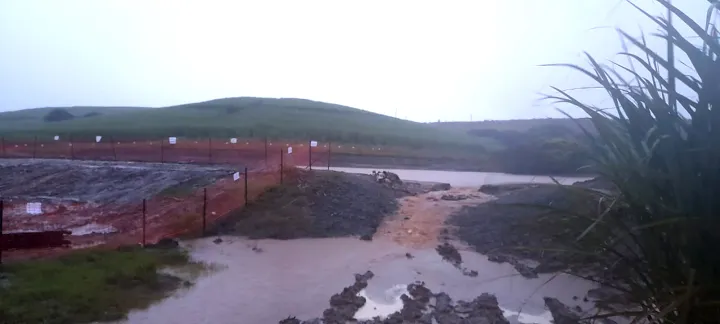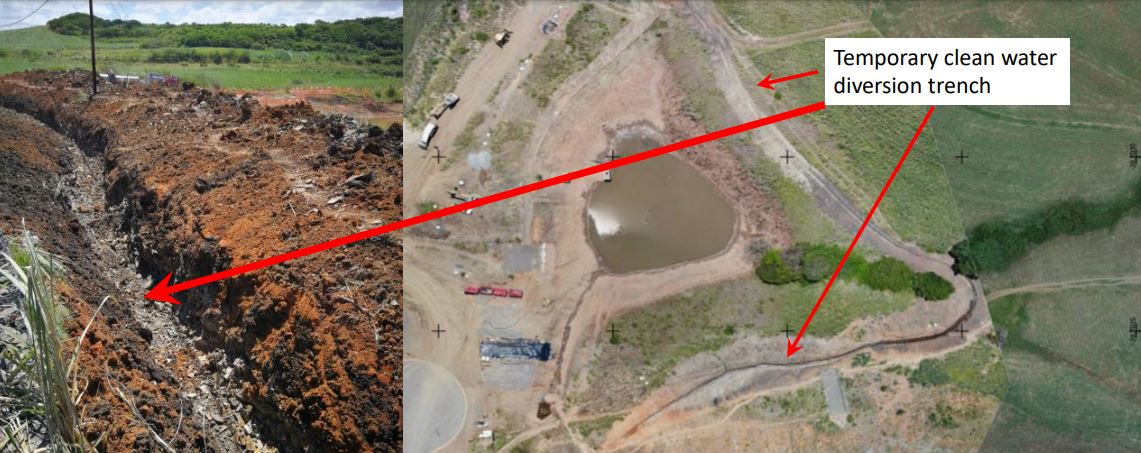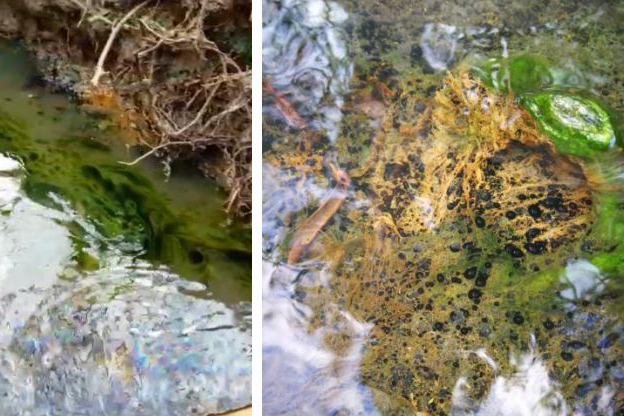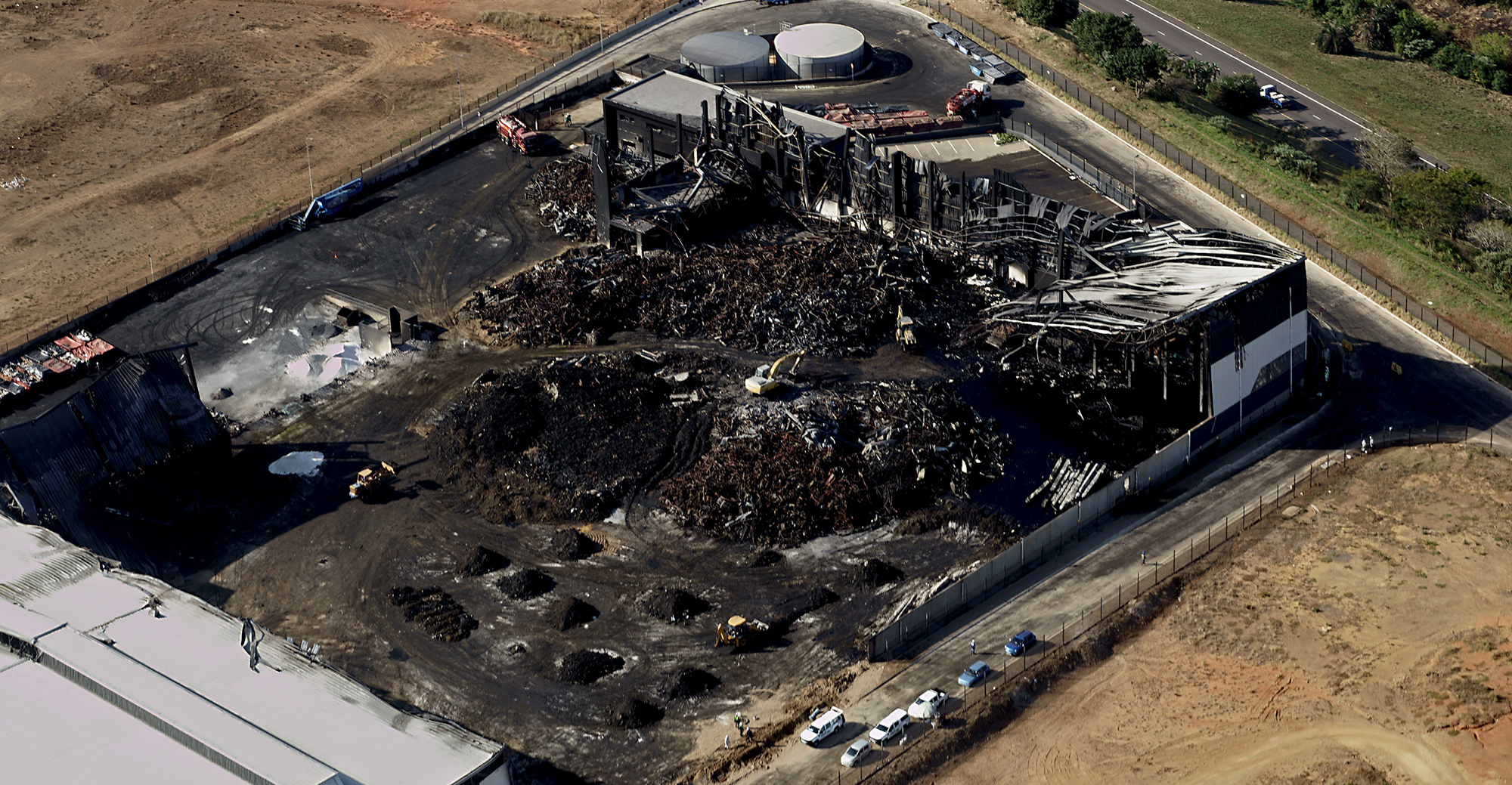PROVINCIAL DISASTER
UPL toxic chemical waste leaks on to Durban beaches again in heavy rains

It is understood that a makeshift ‘pollution control dam’ started to overflow just after 6pm on 11 April at the height of the rains that caused havoc in KwaZulu-Natal.
A “pollution control dam” designed to safely capture toxic and hazardous waste residue from the gutted UPL pesticide warehouse in Durban has overflowed, releasing an unspecified quantity of chemically contaminated wastewater into the Umhlanga River and adjoining beaches north of Durban.
It is understood that the makeshift dam started to overflow just after 6pm on 11 April at the height of the rainstorm that caused havoc in KwaZulu-Natal.
City officials in Durban have not responded to queries on the estimated volume of wastewater that spilled from the dam, nor whether the city will close swimming beaches as a precaution against toxic chemical hazards. However, all Durban beaches are now closed due to heavy seas, debris and pollution generated from several rivers.
UPL, an Indian-owned pesticide and farm poisons supplier, insisted in a media statement on 12 April: “recent levels of metals and contaminants of concern in the pollution control dam were very low” and “no further impacts on the [Umhlanga] estuary or beaches or [safety] exclusion zone are envisaged”.

Contaminated water flows from a breach in the UPL pollution control dam at Cornubia this week. (Image: Supplied)
Activists dubious
But civil society groups monitoring the aftermath of the chemical blaze and clean-up were dubious last night about accepting statements from UPL’s public relations team at face value.
Jeremy Ridl, a Durban attorney and convener of the civil society multistakeholder forum established after the Cornubia chemical inferno, said: “We cannot accept statements from UPL that the wastewater is as benign as they are suggesting, until it is backed up in written statements signed off by the specialists themselves.”
Ridl noted that stakeholders had previously raised concerns about whether the UPL pollution control dam was large enough to handle the water flow from heavy rain events.
UPL, which is facing criminal charges related to alleged safety breaches and the toxic air, soil and water pollution following the massive chemical fire at Cornubia during the July riots, did not respond directly to questions about the estimated volume of chemically polluted water that flowed from the dam this week.
The dam is located a few hundred metres from the warehouse and was established as a temporary measure to collect toxic waste residue flowing from the charred remains of the warehouse during decontamination and clean-up operations.
Since the July arson inferno, at least 65 million litres of contaminated liquid waste from the warehouse and the surrounding area have been trucked to hazardous waste disposal sites, along with about 18 million kilograms of solid waste and nearly four tonnes of fish which died in rivers and along the Umhlanga beachfront.
City denies sea-dumping permission
Last year, UPL applied for permission to dump waste from its pollution control dam (PCD) directly into the sea rather than trucking it at great cost to hazardous waste disposal sites in Gauteng and along the KZN north coast.
The city refused to grant permission for the sea-dumping option at the time.
More recently, the toxicity of water in the PCD appears to have declined, though measurable levels of contaminants such as trimethylbenzene and tebuthiuron were still being recorded during monitoring tests a few months ago.
A recent report by GroundTruth environmental consultants suggests that the dam was expected to overflow after reaching water levels of about 9,000m3.
The report, dated 9 February, states that managing the level of this dam was “critical to prevent overtopping and contamination” of nearby rivers and tributaries. As a result, a trench had been dug nearby to reduce the volume of water entering the PCD.
‘Residual contaminants’
The report also notes that there was visible evidence of “residual contaminants still leaching from stream banks in some areas”. Tests suggested this contamination was linked to diesel and pesticide residue.

Recent visible evidence of ‘residual contaminants still leaching from stream banks in some areas’. Tests suggested this contamination is linked to diesel and pesticide residue. (Source: GroundTruth report)
But, according to UPL spokesperson Japhet Ncube, tests conducted before the recent heavy rains indicated that the levels of metals and pesticides in the pollution control dam were “very low”.
“UPL, with the authorities, were considering a variety of discharge options, including slow release into the river environment,” he suggested.
The company stated that the dam had been emptied by tankers over the last month.
“Sediments were removed to landfill and [the dam] had been fully relined. As a result, there was no mobilisation of sediments in the dam, and none of the risks that would have been associated with them.”
Echoing previous assertions that the initial spill of thousands of tonnes of toxic chemicals in July was “unavoidable” because of the nature of the arson attack on its warehouse, the company said this week’s spill from the pollution control dam was due to “the heavy rains [which] were completely unprecedented.
“The volumes of rainwater in the PCD catchment resulted in the dam levels rapidly rising from nearly empty to extremely high. In response to that threat, UPL resumed extraction to tankers and the specialist team implemented systems to reduce the volume of rainwater entering the PCD. Despite these interventions, due to ongoing heavy rainfall, the PCD still overtopped via a designed overflow system.”
Contingency plans questioned
But attorney Ridl has questioned whether the UPL’s toxic wastewater contingency plans were adequate, also noting that far heavier rainfalls had occurred along the KZN coast in living memory — including the 1984 floods caused by Tropical Storm Demoina, the September 1987 floods and the floods of February 1988.
“The volume of rain over the last week is by no means a record compared to previous flood events in KZN, although the extent of damage has undoubtedly been dramatic, partly due to increased property development and the inadequate management of stormwater associated with recent development.
“So I don’t think you can claim that the dam failure was the result of ‘unprecedented’ or ‘completely unforeseen’ heavy rains as UPL has claimed,” he said.

An aerial view of the UPL chemical warehouse in Durban. (Photo: Steve McCurrach / Bateleurs Flying for the Environment)
Ridl further questioned why the pollution control dam was still in operation if the water contamination levels were as harmless as UPL suggested.
We asked UPL to estimate the volume of contaminated water that leaked from the dam this week, but the company said: “Exact volumes involved can only be assessed once the experts have collected the necessary data.”
Toxicity tests
While the city has yet to comment on whether it is conducting independent water toxicity tests on the beaches north of Durban, UPL said specialists appointed by the company believed that “the contamination in the PCD was itself at very low contamination levels and as a result, UPL’s consultants have advised that at those concentrations, they will be of minimal concern.
“Analytical sampling has been undertaken and continues to be undertaken to verify these assessments. Results will be available on the concentrations of metals and residual pesticides next week to provide information to make any recommendations on adaptive management if required.
“However, given the very low levels anticipated, no further impacts on the estuary or beaches or exclusion zone are envisaged. The previous recommendation that the exclusion zone should remain for six months to aid ecological recovery, is anticipated to remain unchanged.” DM/OBP




















 Become an Insider
Become an Insider
Comments - Please login in order to comment.